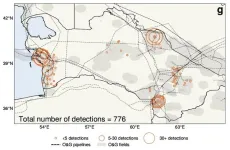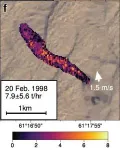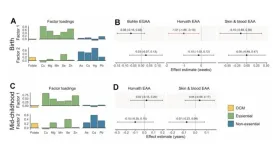(Press-News.org) The collapse of the former Soviet Union in 1991 had social, political and economic effects worldwide. Among them was a suspected role in slowing human-generated methane emissions. Methane had been rising steadily in the atmosphere until about 1990. Atmospheric scientists theorized that economic collapse in the former USSR led to less oil and gas production, and thus a slowdown in the rise of global methane levels, which has since resumed.
But new University of Washington research uses early satellite records to dispute that assumption. The study, published March 12 in the Proceedings of the National Academy of Sciences, finds that methane emissions in Turkmenistan, a former Soviet republic and major oil producer, actually increased in the years following the dissolution of the Soviet Union.
“Methane has these enigmatic trends that we don’t really understand,” said senior author Alex Turner, a UW assistant professor of atmospheric sciences. “One that has always been fascinating is this slowdown in 1992. We find that the collapse of the Soviet Union seems to result, surprisingly, in an increase in methane emissions.”
Carbon dioxide is more important than methane for long-term global warming, but methane plays an important role in the shorter term. One molecule of methane has more heat-trapping power than CO2, and its half-life in the atmosphere is just a decade, meaning its levels can fluctuate.
In recent years, the rise of methane accelerated during COVID-19 lockdowns. Turner’s previous research showed that less driving and thus fewer vehicle emissions containing reactive nitrogen (an air pollutant) likely played a role, because pollution was no longer able to combine with methane molecules to remove them from the atmosphere.
The new study explores a longer-term conundrum: an abrupt slowing in the rise of methane concentrations in the atmosphere in 1992.
Methane’s sources can be hard to untangle since they include both natural sources, such as wetlands, and human-related sources, such as fossil fuels, landfills, livestock digestion and manure. Pockets of methane gas can also escape during extraction of other fossil fuels. Methane is sometimes even burned, or flared, if it is not the main target of exploration.
The new study focused on Turkmenistan, a central Asian oil-producing country where economic data show that gas production dropped by 85% between 1991 and 1998. This steep decline suggests it played a major role in the region’s overall drop in energy production. The country also has relatively little tree cover, making it a good candidate for satellite observations.
The authors used images of Turkmenistan taken by NASA’s Landsat-5 satellite, one of the first Earth-observing satellites. First author Tai-Long He, a postdoctoral researcher in atmospheric sciences at the UW, and co-author Ryan Boyd, a former UW undergraduate, identified methane emissions in satellite images and then trained an AI model to catalog similar methane plumes in the entire data set.
“Our field has a lot of data sets, but we don’t have very efficient tools to analyze them,” said He. “This will become worse in the future with more satellites being launched, so we need the help of AI to improve our understanding of atmospheric phenomena.”
Their technique identified 776 plumes over the 25-year period from 1986 to 2011. Analysis shows methane plumes grew in size and became more frequent after 1991, when economic data for Turkmenistan show a decrease in gas production. In some oil and gas basins, methane plumes appeared in 80% to 100% of the clear-sky images during the post-collapse period.
The authors speculate that reasons might include failing infrastructure, broken components, less oversight of oil and gas wells, and fewer export routes, which led to more deliberate or unintentional off-gassing.
“The year 1994 stands out as the year with the largest methane emissions,” Turner said. “That’s fascinating, because that’s the year that Russia refused to allow Turkmenistan to pump gas through its pipelines to European markets. So we think the gas production was still reasonably high, but they couldn’t sell their gas to anyone, resulting in more methane venting to the atmosphere.”
The authors suspect the rest of the former Soviet republics would show similar trends to Turkmenistan, but they can’t yet say for certain.
“More broadly, it begs the question of what drove the 1990s slowdown in atmospheric methane,” Turner said. “I don’t actually know. But when we started this work, I expected to confirm the hypothesis. So it was a pretty surprising finding.”
The other co-author is Daniel Varon, a research scientist at Harvard University. Boyd is now a graduate student at Princeton University. This research was funded by NASA, a grant from the Schmidt Futures program and the Environmental Defense Fund, a nonprofit based in New York City.
END
AI analysis of historical satellite images show USSR collapse in 1990s increased methane emissions, despite lower oil and gas production
2024-03-12
ELSE PRESS RELEASES FROM THIS DATE:
Charging up the commute
2024-03-12
A team of researchers at Oak Ridge National Laboratory demonstrated that a light-duty passenger electric vehicle can be wirelessly charged at 100-kW with 96% efficiency using polyphase electromagnetic coupling coils with rotating magnetic fields.
ORNL’s patented system transferred power to a Hyundai Kona EV across a five-inch airgap using electromagnetic fields, a process similar to the wireless charging of small consumer devices.
“We’ve achieved the highest power density in the world for a wireless charging system for this class of vehicle,” ORNL’s Omer Onar said. “Our ...
$5 million grant bets on computational biology, AI to change the future of cancer
2024-03-12
SAN FRANCISCO—A multidisciplinary research team at Gladstone Institutes, led by Senior Investigator Katie Pollard, PhD, has received $5 million in funding through a newly launched grant program designed to ignite a fresh wave of cancer discoveries using computational biology and artificial intelligence.
The new Transformative Computational Biology Grant Program from the Biswas Family Foundation, in partnership with the nonpartisan think tank Milken Institute, is providing a total of nearly $14 million to five research groups.
At Gladstone, the grant establishes ...
Integrating renewables and machine learning for improved grid stability
2024-03-12
In the race to achieve a net-zero future based on clean energy, renewable energy sources like solar and wind power have emerged as potential champions in the battle against climate change. However, as traditional synchronous generators are replaced by inverter-based renewable energy resources, the transition creates a low-inertia challenge within the existing power grids leading to stability and reliability concerns.
Xingpeng Li, assistant professor of electrical and computer engineering at the University of Houston, is working on a solution that will allow seamless integration of renewable energy ...
Global ecosystem contribute trillions in its services with key synergies and trade-offs
2024-03-12
Trade-offs and synergies between ecosystem services constitutes an important topic in ecosystem management. The value of each service is substantially influenced by human activities, and changes will affect human decisions. Given the variability in trade-offs and synergies, the simultaneous optimization of multiple ecosystem services presents a considerable challenge.
In a study published in Environmental Science and Ecotechnology, a team from the Chinese Academy of Environmental Planning, which has completed ...
Association of prenatal vitamins and metals with epigenetic aging at birth and in childhood
2024-03-12
“[...] our findings support the hypothesis that the intrauterine environment, particularly essential and non-essential metals, affect epigenetic aging biomarkers across the life course.”
BUFFALO, NY- March 12, 2024 – A new research paper was published in Aging (listed by MEDLINE/PubMed as "Aging (Albany NY)" and "Aging-US" by Web of Science) Volume 16, Issue 4, entitled, “Associations of prenatal one-carbon metabolism nutrients and metals with epigenetic aging biomarkers at birth and in childhood in a US cohort.”
Epigenetic gestational age acceleration (EGAA) at birth and epigenetic age acceleration (EAA) in childhood may be biomarkers of ...
Gun manufacturers’ ads appeal to women as ‘serious students’ of firearms to boost sales
2024-03-12
CORVALLIS, Ore. – Gun manufacturers are appealing to women as “serious students” of firearms in their advertising – a shift in strategy over the last two decades that may be contributing to increased gun sales, a new study shows.
From 2007 through 2022, women’s gun ownership rose from 16% to 22%, while the rate for men stayed roughly steady at 43%. And more than half of new gun owners in the United States between 2019 and 2021 were women.
“Those trends in gun ownership ...
In the resuscitation discussion, do words matter between doctors and patients?
2024-03-12
Adults 65 and older, who were hospitalized for a variety of medical conditions, had highly satisfying conversations about whether they wanted CPR, regardless of whether doctors used the terms “allow a natural death” or “do not resuscitate” for indicating no CPR, according to a pilot study by Rutgers Health researchers.
The study, published in the Journal of the American Geriatrics Society, sought to determine the best language doctors could use when discussing a patient’s code ...
PPPL unveils new laboratory space to advance quantum information science
2024-03-12
Building on its more than 70 years pioneering the study of fusion energy, the U.S. Department of Energy’s (DOE) Princeton Plasma Physics Laboratory (PPPL) has added a new field to its research portfolio — quantum information science.
On March 11, PPPL opened its new Quantum Diamond Lab (QDL), a space devoted to studying and refining the processes involved in using plasma, the electrically charged fourth state of matter, to create high-quality diamond material for quantum information science applications. Scientists around the ...
Women with depression face higher cardiovascular risk than men
2024-03-12
People with depression face an increased risk of cardiovascular disease (CVD); however, more women experience CVD following a depression diagnosis than men, according to a new study published today in JACC: Asia. The study investigates the connection between depression and CVD, shedding light on potential mechanisms that contribute to its sex-based differences and underscoring the importance of tailoring CVD prevention and management strategies according to sex-specific factors.
Depression is the third leading cause of morbidity worldwide. Prior research shows that it is associated with a heightened risk of cardiovascular events, ...
SLAS announces $100,000 graduate education fellowship grant awarded to Lan Mi of the University of Massachusetts Amherst
2024-03-12
Oak Brook, IL (March 12, 2024) – The Society for Laboratory Automation and Screening (SLAS) is pleased to announce Lan Mi, Ph.D. candidate in the Department of Chemistry from the University of Massachusetts Amherst (Amherst, Massachusetts, USA), as the 2024 SLAS Graduate Education Fellowship Grant recipient.
The SLAS grant will support Mi's research regarding the synthesis and applications of fluorogenic RNA aptamers for extensive in vitro and in vivo investigations. It will also support her work in developing and assessing fluorogenic RNA-based sensors, employing high-throughput ...







